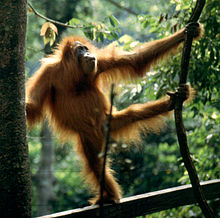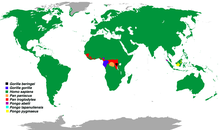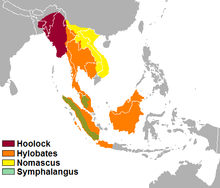List of hominoids
Members of this superfamily are called hominoids or apes, and include gorillas, chimpanzees, orangutans, gibbons, bonobos, and humans.
The majority are found in forests in Southeastern Asia and Equatorial Africa, with the exception of humans, which have spread worldwide to every biome.
Hominoids primarily eat fruit, leaves, flowers, and insects, though humans are omnivorous.
Most hominoids do not have population estimates, but the ones that do range from 10 mature individuals to 47,000, in addition to over 8 billion humans.
Dozens of extinct prehistoric hominoid species have been discovered, though due to ongoing research and discoveries the exact number and categorization is not fixed.
[1] Conservation status codes listed follow the International Union for Conservation of Nature (IUCN) Red List of Threatened Species.
Ranges are based on the IUCN Red List for that species unless otherwise noted.
The superfamily Hominoidea consists of two extant families: Hominidae and Hylobatidae.
Family Hominidae Family Hylobatidae Pongo Gorilla Pan Homo Hylobates Nomascus Hoolock Symphalangus The following classification is based on the taxonomy described by the reference work Mammal Species of the World (2005), with augmentation by generally accepted proposals made since using molecular phylogenetic analysis, as supported by both the IUCN and the American Society of Mammalogists.


